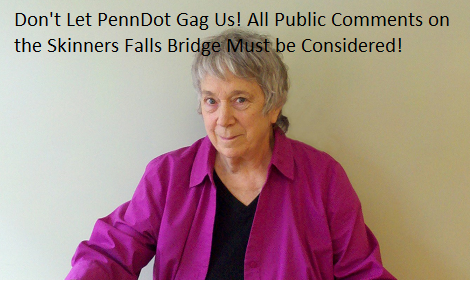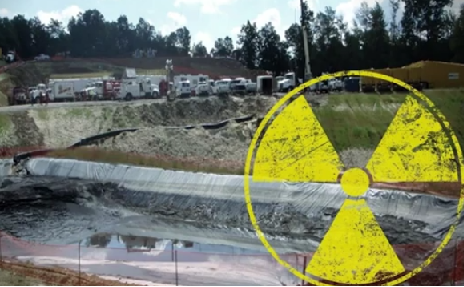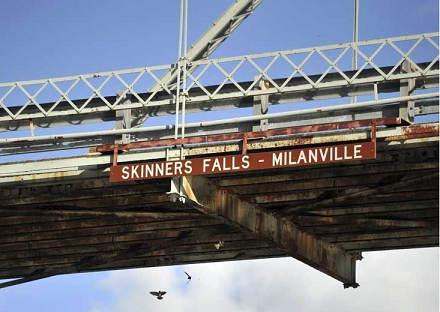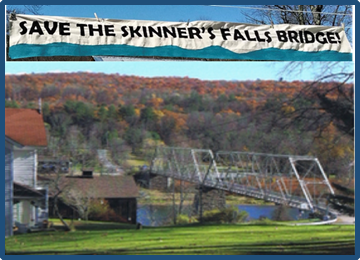
PennDOT Ignores Skinners Falls Bridge Public Comments – DCS Fights Back
August 29, 2021
Radioactivity in Fracking! Too Hot to Handle – Webinar
September 4, 2021By Liam Mayo, The River Reporter, August 31, 2021
DCS feels strongly that all voices with an interest in PennDOT’s Skinners Falls project must be heard. That is why we wrote to PennDOT and that is why we will fight PennDOT in court, if necessary. Your donation to the Ed Wesely Fund to save the Skinners Falls Bridge helps us fight to make your voice heard.
On Tuesday, August 29, the Damascus Citizens for Sustainability (DCS) sent a letter to the Pennsylvania Department of Transportation (PennDOT) accusing it of “failure to engage in a real public participation process for the Skinners Falls Bridge.”
The Milanville-Skinners Falls bridge project has been underway for several years. The bridge has been closed since an October 19, 2019 inspection revealed significant structural deterioration, and PennDOT has been working since then on plans to repair or replace it.
The current phase of the project involves PennDOT preparing a Planning and Environmental Linkages (PEL) Study for the bridge, together with the Federal Highway Administration and the New York State Department of Transportation. The study is meant to identify local transportation needs and potential project options, weighing the historic value of the current bridge—a presentation on PennDOT’s website cites it as the oldest bridge in the Upper Delaware Region—with the economic possibilities of a replacement bridge with full weight access.
PennDOT solicited public feedback and comments as part of the PEL Study process, a necessary step for the study to be incorporated into a subsequent guiding National Environmental Policy Act (NEPA) document. A survey conducted between March 31 and June 1 sought to capture this feedback according to specific metrics, while PennDOT provided email addresses for the implied purpose of additional comment. PennDOT has also solicited public input through a Project Advisory Committee with participation from local community bodies, the next meeting of which will take place mid-September.
PennDOT has since released a report on the results of the survey, indicating that these results will be incorporated in the PEL Study process. But that report explicitly excludes comments sent in via email, and as of yet, PennDOT has not provided a comment response document or other evidence that comments submitted outside the bounds of the survey will be separately considered.
That exclusion formed the basis for the letter sent by DCS. “Given the large volumes of correspondence that PennDOT received outside the confines of the Survey,” the letter reads, “PennDOT has arbitrarily excluded a significant amount of relevant information that would very likely alter the outcome of the PEL Study.” (See full text on their website.)
In comments to the River Reporter, DCS director Barbara Arrindell said that excluding comments submitted by email, especially from organizations such as the Upper Delaware Council and the National Park Service, could significantly impact the outcome of the PEL Study. “It certainly looks like PennDOT is once again trying to stack the deck in favor of its preferred outcome, which history suggests is one that ignores environmental needs and historic heritage in support of imposing massive industrial grade projects in locations where such structures are not only unneeded but destructive.”
“We encourage anyone who cares about the preservation of the bridge to contact PennDOT and let them know your concerns about the process the agency is conducting to make decisions about this bridge that will affect all of our lives, and insist on being heard,” Arrindell added.
While comments submitted by email were explicitly excluded from the survey summary, it remained unclear whether they would be excluded from consideration entirely. Such comments, when submitted, received a response including the language, “Your comments have been noted and will be considered in the planning process.”
Laurie Ramie, the executive director of the Upper Delaware Council and the recording and corresponding secretary for the Upper Delaware Scenic Byway, spoke for both organizations and said they were under the impression that comments would be included. “It would be news to me if that was not the case.”
The option to email comments was especially important for organizations, Ramie added. How could an entire group comment collectively in a single survey, a survey designed to track individual opinions?
The importance of non-survey comments to organizations could make the exclusion of comments especially significant. In the letter DCS sent to PennDOT, it stated that the lack of appropriate consideration of public comments could open the process and any resultant NEPA document up to legal challenges.
As of the time of writing, comments from PennDOT are still forthcoming. If you have any questions or comments, or would like to be added to the project mailing list to receive future updates on the Skinners Falls Bridge PEL, please contact the project hotline at 610/234-5148 or Skinnersfallsbridge@aecom.com.




